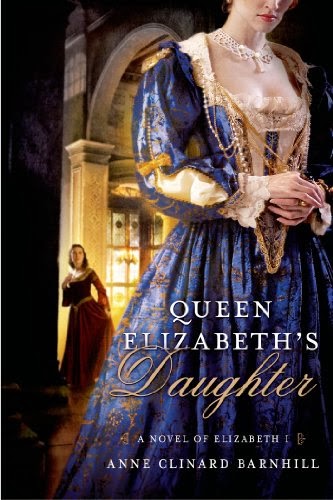Today’s post is a guest article from author Anne Clinard Banrhill, whose latest novel, Queen Elizabeth’s Daughter: A Novel of Elizabeth I, will be released in the US on March 18, 2014.
Enjoy!
Sir John Scudamore
Sir John Scudamore does not, at first glance, seem to have the dashing qualities of a romantic hero: he was born in 1542 in Herefordshire. At the death of his father, he became a ward of Sir James Croft. Croft craftily arranged a marriage between his daughter, Eleanor and young Scudamore. They married sometime around 1561. He would have been nineteen. From then, until 1569, Eleanor and John had five children. Unfortunately, Eleanor died, leaving Scudamore a young widower.
In his grief, he immediately went to London, having been granted entry into the Inner Temple to study law. He seems to have left his young children in Herefordshire, most likely with their grandmother. Perhaps he hired a nanny. We don’t know. All we know is, when he arrived in London, his otherwise prosaic life was about to change.
Since Scudamore plays a large role in my new novel, QUEEN ELIZABETH’S DAUGHTER, I thought it would be important to figure out a little about his character, to discover what sort of man he was. While research doesn’t reveal a great deal about this man who eventually serves at court, we can make a few conjectures. First, he must have been a young man with healthy appetite—five children in less than ten years would indicate a certain vigor. He must also have been ambitious—he had already applied to the Inner Temple before his wife died. Her death did not deter him. Scudamore was happy to accept his former father-in-law’s help in procuring a place for himself at court. According to a letter from Croft to Scudamore, the queen spoke of the young man ‘with better words than I think your younge yeres can yet deserve.” There was something about him, evidently, Queen Elizabeth liked. She named him a Gentleman Pensioner in 1572 and he was eventually promoted to standard bearer.
Though ambitious, he remained a Catholic, though being a recusant was increasingly frowned upon by the Queen and, especially, her advisers, Cecil and Walsingham, who were staunch Protestants. Clinging to his religion, though such stubbornness may have brought him trouble, indicates a strong character, someone not afraid to stand up for his beliefs. Now, he begins to seem more heroic.
 And, though the father of five, a serious student and a committed servant to Queen Elizabeth, there must have also been a romantic, bold streak running through him because in 1574, he married Mary Shelton, the queen’s ward and second cousin. He married her in secret, against the queen’s command. As a result, Elizabeth I famously broke Mary’s finger and banished them from court. To risk so much for love seems romantic to me because the risk was quite real—Elizabeth had put several people in the Tower for such defiance, including another cousin, Lady Catherine Grey, who was imprisoned until her death. So, Sir John Scudamore becomes the hero of Queen Elizabeth’s Daughter based on his daring and his determination to hold fast to his beliefs.
And, though the father of five, a serious student and a committed servant to Queen Elizabeth, there must have also been a romantic, bold streak running through him because in 1574, he married Mary Shelton, the queen’s ward and second cousin. He married her in secret, against the queen’s command. As a result, Elizabeth I famously broke Mary’s finger and banished them from court. To risk so much for love seems romantic to me because the risk was quite real—Elizabeth had put several people in the Tower for such defiance, including another cousin, Lady Catherine Grey, who was imprisoned until her death. So, Sir John Scudamore becomes the hero of Queen Elizabeth’s Daughter based on his daring and his determination to hold fast to his beliefs.
Eventually the queen forgave them and brought them back to court. Sir John continued in service and was made a knight in 1592. He outlived his wife, Mary, by about twenty years, having retired to his beautiful Tudor house, Holme Lacey. He died in 1623.
Official website of author Anne Clinard Barnhill: http://anneclinardbarnhill.com/


















Hi Anne, good luck with your latest novel. I’m looking forward to reading about the finger breaking in detail! What a woman!
Thanks so much for hosting me!
My pleasure!
Thanks, Debbie–I hope you enjoy it!